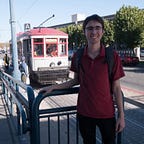Introducing Move Bay Area
Motivated by the MTC’s (regional transportation agency for the San Francisco Bay Area) Horizon Request for Transformative Projects contest, Jason Lee and I decided to make a detailed, thought-out, and intuitive blueprint for the transportation network that will be vital in allowing the Bay Area to grow sustainably. Our chapter on Fare Integration was selected as one of the 12 finalists. It’s called Move Bay Area and you can check it out here.
This post summarizes our thought process behind the decisions we made, which are described in-detail in the report. As well, here’s a post I wrote on generating the maps that we used to visualize the extent and frequency of current and proposed transit:
We started by looking at the Bay Area’s past, noting how expansive Muni’s streetcar network was when it became the Nation’s first public transit system and how BART was more effective than the former Key system at intra-East-Bay travel; but most importantly, we highlighted that transit has been moving slower and running less frequently for the past two decades, which explains why transit ridership has been declining.
Then we set our eyes on the regional context, and examined the effectiveness and limitations of BART, Caltrain, and Amtrak (Capital Corridor). We decided to propose a high-frequency electrified rail corridor going from San Jose along the peninsula to San Francisco, continuing on to Emeryville through a new Transbay tunnel, and then following the Capital Corridor to Sacramento. Additionally, we decided to propose extending BART’s reach using DMU (ie. eBART) technology due to longer distances and reduced cost.
For the local context, we focused on service. Why? Because even with a solid regional rail link, many potential riders may still choose to drive or Uber/Lyft the whole way due to inconvenient local transit service for their first and last miles. We proposed tying the number of revenue-miles completed by transit agencies to the population of the area they’re serving as to form a metric that remains constant only if cities choose to invest more in transit as their population increases.
Lastly, we discussed fare-integration, which when neglected results in a inequitable barrier to regional mobility, undermining the investments made in expensive capital projects such as BART and the Caltrain electrification. We gave a talk at SPUR on November 15 — here are the slides we made with Ian Griffiths (Seamless Bay Area) and Arielle Fleisher (SPUR) here.
And that’s Move Bay Area, our blueprint for sustainable transportation by 2050. Feel free to leave your questions/comments below and check out our final report here: https://move-bay-area-files.s3.ca-central-1.amazonaws.com/Move_Bay_Area.pdf
